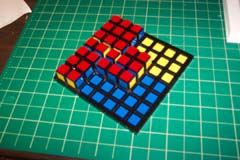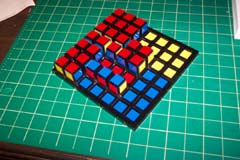Explore

Designer
Eric Harshbarger; eric@ericharshbarger.orgManufacturer
SelfDates of Design
June 2004
Date of first public disclosure or manufacture
June 2004Materials used
ABS plasticGoal/problem statement
- Start by placing the blocks on the board in an arrangement so that the red squares on the board are covered by the blocks and the red squares of the blocks face upward (there are multiple ways of doing this).
- Blocks are then moved by "rolling" them edgewise to empty, adjacent squares of the board (a new color of square will then be face up on the block, and that block will be covering completely new squares of the board). After a move, the blocks must be completely contained within the board's boundaries (no part of a block may hang over the edge of the 7x7 board).
- The final goal is to maneuver the blocks so that all of the yellow squares of the board are covered and, at that point, all of the blocks show yellow squares face up. Before reaching the final goal, however, one must first reach an arrangement ("interim goal") that covers all of the blue squares of the board with the blocks all showing blue squares upward. The goal is to accomplish the final goal in as few moves as possible.
- Note that after intermediate moves (between "start", "interim", and "final goal"), face-up squares on blocks need not color-match the squares of the board they are covering -- this is only a requirement at the start, interim and final goal stages.
Solution
Below is one possible solution (found by myself, Eric Harshbarger). It is not the best known. In the notation below, the six blocks are referred to by their unique sizes (largest area they may cover when lying flat): 9, 6, 4, 3, 2, 1. A move is indicated by a "#d" code where "#" is the block moved, and "d" is the direction moved (so, "3R" would indicate rolling the 3-block to the right).The starting arrangement assumes that the board is oriented such that red squares dominate the left side of the board; uncovered blue and yellow empty spaces of the board (at the start) are shown by "b" and "y" respectively. The square blocks can be oriented in a couple of ways. In the starting position this example solution, it is assumed that the 9 and 1 blocks have blue side-squares along their left/right edges, while the 4 block has its blue side-squares along the top and bottom.
An ASCII representation of the board is below:
999yyyy 999yyyy 99944yy 22144bb 66333bb 66bbbbbHere is a solution in 64 moves:
3D,3D,4R,4D,4L,4U,4R,4D,4D,1R, 1R,1R,1U,1U,2R,2R,2R,6U,6R,3U, 3R,6D,6D,9R,9D,9L,9U,9R,2L,2L, 3L,3L,9D,9R,3R,2R,2R,2D,1D,1D, <-- (blue squares covered at this point -- 9U,1U,1U,1U,3L,6U,6U,6U,6R,4L, "interim goal" achieved after 40 moves), 4U,4U,4U,4U,2L,2U,2L,2U,2U,2R, 3U,3R,3R,3UThe two photographs show Explore puzzle in the initial start arrangement above, and then the board after the first move (3D).
Puzzle Classification
Rolling Block/Maze.Additional information
This puzzle was purposely designed to be "open-ended" in the sense that a definitive solution is not known (for that matter, the "best" starting position is not even known). Short of extensive computer analysis or a complex proof, it is not immediately clear what the best (shortest number of moves) solution might be. The user is encouraged to find a solution, and then "explore" with the blocks and try to find a better solution.The official goal is to start the blocks on the red squares and end up on yellow squares after achieving the blue squares. This could be abbreviated as the "R>B>Y" challenge. Of course, other challenges are possible (for example, "B>R>Y"). It is interesting to note that there is a (very efficient) solution to "R>B" which may not be extended to solving "R>B>Y".
I assembled this puzzle by hand. I have no immediate plans to sell it, but if there is interest in additional copies being made, I will consider it (and, of course, if a manufacturer wishes to approach me about marketing it, I am open to that).
If there are any question about the above instructions, do not hesitate to contact me.
Better Solution
My friend, Robert Ford, has obtained the best solution to date for the R>B>Y challenge -- 47 moves. Starting arrangement:999yyyy 999yyyy 99922yy 33344bb 66144bb 66bbbbb 66bbbbb(9 and 1 block have blue side-squares on left/right sides, the 4 block has blue side-squares on top/bottom).
4R,4D,4L,4L,1R,1D,1D,3R,3R,3D, 3D,3D,2D,2D,2D,9D,9R,9U,9R,9D, 6U,6R,6U,6R,6D,9U,6U,2U,2U,2U, 2U,2U,2R,4U,4U,4R,4U,1U,1U,1U, 1U,1R,1U,3U,3L,3U,3UCopyright 2004, Eric Harshbarger